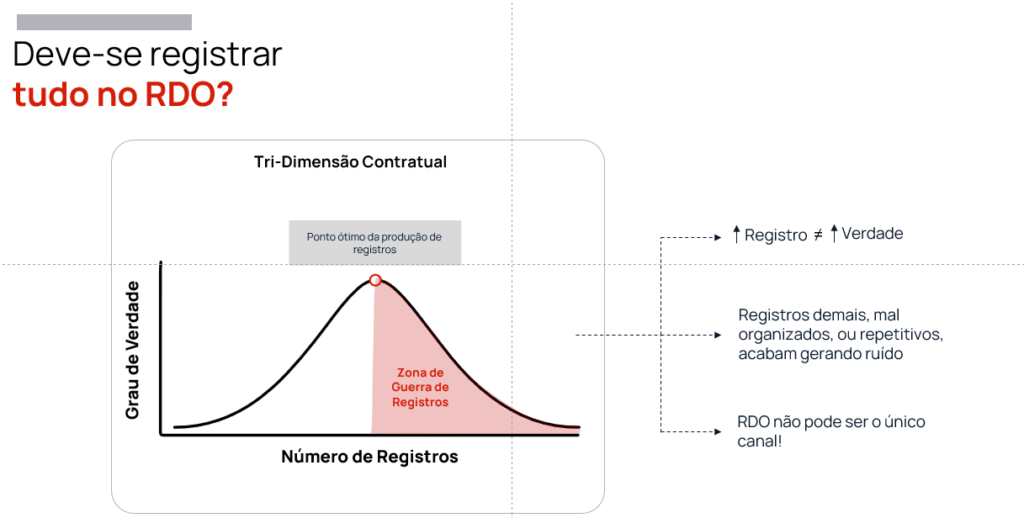The Daily Works Report (RDO) is a fundamental tool in the management of any construction project. However, it is often misunderstood and sometimes turned into the "wailing wall" or "credit book" of the construction site. For the daily work report to function as an effective tool for contract management and administration, it is crucial to know what and how to record, ensuring clarity and legal security.
Below, we present the main topics and guidelines for the correct drafting of the RDO ( Report of Contractual Activities), as discussed by experts in contract administration:
What is RDO and what is its role in the contract?
The Report (RDO) is essentially a basic record-keeping tool . It should not be the most important document of the project, since the information contained in it is usually duplicated in other more specific records, such as measurements, schedules, and payrolls.
With the advent of contract management, the "fetish of records" was created—the idea that everything should be recorded in the site log . This is a mistake. The site log is not a "credit book" where outstanding payments are noted for future collection, as this approach transforms record-keeping into a crutch for incompetence, avoiding the necessary work of project analysis, measurement, and negotiation.
For more details, watch our full live stream on the subject:
The Importance of Objectivity in Writing a Construction Log
The construction log should be written objectively . Ideal language uses nouns, action verbs, and objects (subject, verb, and concrete element).
What to avoid:
- Emotions and Adjectives: Avoid using adjectives (e.g., "We are extremely worried") or adverbs. If you want to write adjectives, "write a book of poetry, not a diary of works."
- Writing crutches: Avoid phrases like "we warned about the problems" or "we are extremely concerned."
- Discussions and Bickering: The RDO (Regional Development Office) should not be a place to extend discussions on a subject. If the discussion drags on, it is a sign that the people in the field do not have the competence (ability) to solve the problem; it is necessary to find someone with that ability.
- Conflicting Texts: Confusing texts or texts with grammatical errors are common, especially because communication in a work is done by people who are often not literature specialists. However, the goal should always be clarity so that the message is not misinterpreted.
The Three Essential Dimensions of RDO: Area, Price, and Project
The RDO (Registration of Contracts) should focus on the fundamental aspects that define the execution of the contract: area, price, and project .

It is crucial not only to record the problem, but also to anticipate it . The team's actions should focus on:
- Area: Check if the area is clear.
- Project: Analyze whether the projects are correct and complete for execution.
- Price: Check if the service spreadsheet includes a price for the activity to be performed.
The biggest difficulties faced by the owner (and which should be recorded) are the incompatibilities between specifications and prices, interferences in the subsoil, lack of area release, and delays in submitting projects.
Avoiding the “Registration War Zone” and Reducing the Level of Information
When copyright registration turns into a prolonged dispute (“copyright war”), the truth disappears, the relationship is damaged, and it becomes impossible to reconstruct the history of the work. In these cases, the recommendation is to avoid this war at all costs .

The RDO is located on the second layer of the Dultra Pyramid, a level where records tend to be in a "war zone" because the contract and laws are highly open to interpretation.
For greater credibility and to resolve problems, the ideal approach is to lower the level of record-keeping to the engineering document layers (levels 3, 4, and 5). Examples of engineering documents that should be prioritized over the construction log include:
- Project control list (PCR).
- Measurements (record of what was done).
- Topographic survey reports (for the release of land surveys, for example, signed by the parties involved).
- Executive procedures and quality documentation.
How to Record Activities and Specific Impacts in the Daily Report
Assuming the Daily Work Report (RDO) will be used correctly, it should contain basic day-to-day information about the work:
| Basic RDO Information | Necessary Details |
|---|---|
| Identification | Date, location, scope, contractor, and client. |
| Climatic Conditions | Whether there was rain, the rainfall amount, and whether the weather was good, cloudy, or rainy. |
| Resources | Labor (direct and indirect), equipment, and subcontractors. The nomenclature must conform to the contractual histogram to allow for correlation. |
Record of Activities Performed:
The activities performed should be recorded considering three aspects:
- Status: Whether it is starting, continuing, ending, paused, or resumed (stating the reason for the pause).
- Description: Preferably, follow the schedule (using the activity ID) to allow for correlation.
- Area: Describe the area according to the project and schedule.
Record of Specific Impacts:
Point-in-time impacts are specific occurrences with a well-defined cause and impact (e.g., a work stoppage due to lack of access authorization).
An effective commentary on a specific event should:
- Define the time frame for the interruption.
- Identify the specific reason.
- Specify the impacted activity (including the schedule ID).
- Indicate the release time (if applicable).
- List the resources (employees and equipment) that were out of service and the period during which they were available.
Example of effective record keeping: “Electromechanical assembly activities (ID X) at substation Y were halted due to a delay in the release of the PTS. The release occurred at 10:00, making it impossible to start before 10:30. The civil team (list of employees/equipment) was idle between 8:00 and 10:00.”
The RDO as Part of a Document Management System

The Daily Work Report (RDO) is ineffective for recording systemic impacts (those that affect the project as a whole and are recurring, such as delays in project approval or missing quantity/price information in spreadsheets).
To anticipate and resolve systemic problems, the record should be kept within the project management system . This allows for predicting the future of the contract.
Instead of recording it in the construction log :
- Project Issues/Technical Information: Issue Technical Inquiries (TIIs) or Requests for Technical Information to obtain answers from the client and define the planning.
- Scope Changes: Submit a Change Request (CR) , detailing the reason, supporting documentation, and the cost and schedule impact.
- Area Clearance: Use monthly or weekly reports, illustrative maps, and (signed) topography reports to document uncleared areas (backlogs).
- Additional Services (Economic Order): Ideally, project analysis should be conducted in advance, and a takeoff proposal with a new price should be submitted. Formalizing the execution of additional services should be done through contract addenda or Extra Service Authorizations/Orders (OIN), allocating personnel and equipment and obtaining the signatures of the parties. What should not be done is to provide the service for free or "sell it on credit."
In summary, the Daily Work Report (RDO) is a necessary daily record, but its main function is to be a basic record of specific facts and resource allocation. Effective project management and the resolution of systemic problems depend on an integrated analysis of projects, costs, and schedules, and the use of more specific engineering documents.




